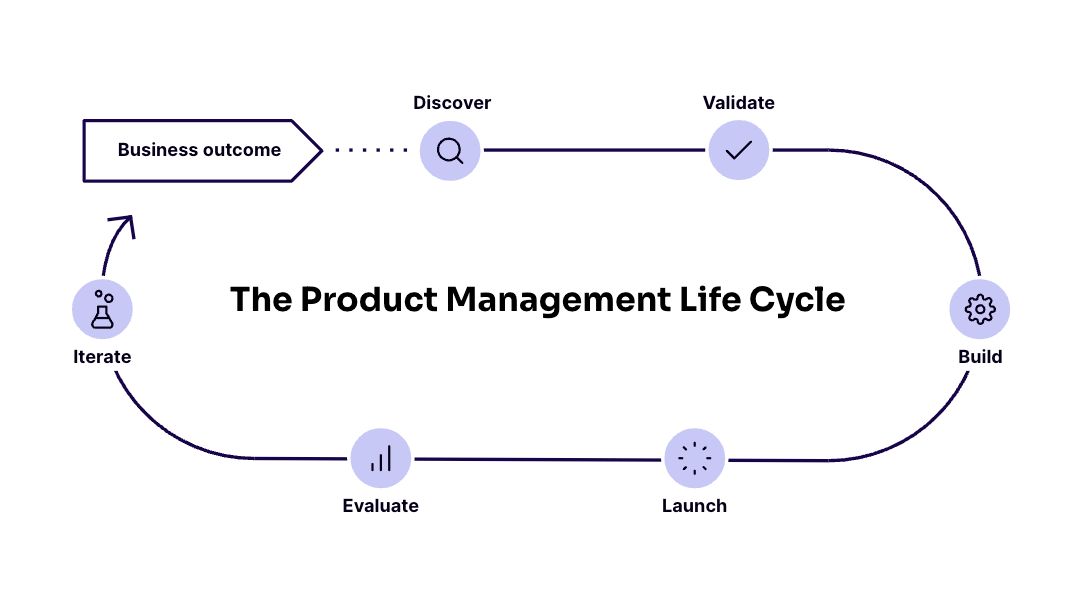How a product experience platform helps PMs at every step of the product life cycle
For product managers (PMs), this problem compounds when you factor in all the inputs necessary to make informed decisions about resourcing and roadmapping—from business goals to product usage data to user feedback. So how can PMs free themselves from the pain and mental load of bouncing between tools to get the insights they need? The short answer: Ditch those point solutions.
The problem with point solutions
While it may be tempting to build your own product experience stack, piecing together point solutions can cause some serious headaches—especially if you’re a PM who has to live and work in that mishmash of tools each day.
From an operational perspective, getting buy-in from your leadership and procurement teams for multiple tools is far more tedious (and time-consuming) than building a single proposal for a unified platform. Plus, if you run into any issues or experience outages with any of those tools, it can interrupt critical workflows. And you’re left playing phone tag with multiple support teams and begging your engineers to fix broken integrations and APIs.
But perhaps the most egregious issue with relying on point solutions—especially in the world of product management—is how they silo your data, making it impossible to identify actionable insights and signals in the noise. For product teams, this lack of cross-pollination between tools is the kiss of death for efficiency. It turns the trope of “too many tabs” into a daily reality for PMs, as they have to shift between multiple platforms (each with its own UI and training requirements) to get all the data inputs they need—then move information in and out of tools to analyze it in aggregate. In other words: Spreadsheet purgatory.
And finally, because point solutions tout themselves on being bespoke solutions, built for specific audiences, they force different teams to work from different sources of truth. Not only does this build mistrust in the data (Which tool is the most accurate? Which data source is actually the most current?), it also means that decisions get made in silos all across your organization. So business intelligence data doesn’t inform your product roadmap. Product usage data doesn’t inform your customer success motions. And customer sentiment data doesn’t inform your marketing strategy. It’s a vicious cycle.
But there’s a better way.
How to use a product experience platform throughout the product management life cycle
A unified product experience platform—like Pendo—brings all of the insights you need to build better digital experiences together, under one roof. So user feedback can inform your design process, product data can proactively prevent churn, and visual data can help your sellers drive higher quality conversions.
For product teams, in particular, a product experience platform brings all the most important inputs and tools needed at each step of the product management life cycle into one place—making it possible for PMs to get the big picture, build trust in the data, and quickly act on their findings. Let’s take a closer look.

Streamlining discovery
Product discovery is a critical—but easily overlooked—step in the product management life cycle. During the discovery phase, PMs (and other teams like product design and user experience) ask questions and dig into the data to triangulate and identify solutions to the problems users are experiencing. This requires having a solid understanding of product usage trends, visibility into user behaviors, and clear themes distilled from customer feedback.
A product experience platform like Pendo allows product teams to analyze and explore the ties between all of these inputs—quantitative, qualitative, and visual data—in one place. No more bouncing from a tool that only surfaces analytics (like Amplitude) into a tool that only collects feedback (like Qualtrics) to compare and contrast product activity to user sentiment. And no more poring through thousands of replays (in a tool like Full Story) to then have to manually identify whom to target with in-app messaging (in a tool like WalkMe).
With Pendo, all of these inputs are at your fingertips, in a single tool. You can see how people are using your product using Pendo Analytics, compare their behaviors to their feedback and product requests using Pendo Feedback, and dig into specific user sessions to diagnose problems using Pendo Session Replay. And because all of these tools are part of the Pendo ecosystem, they help inform each other—and help PMs accelerate their entire discovery process.
Enabling validation and testing
Like discovery, validating your product ideas (ideally, before you spend a lot of time or money building them) is an important—but often undervalued—step in the product management life cycle. While one-on-one conversations with customers are a great way to get detailed input on your product and feature ideas, they aren’t scalable. But with a product experience platform, you can leverage myriad, always-on sources of product and user insights to help test your ideas and validate your decisions—before bringing them to market.
For example, you can use Pendo Analytics to gather usage data on specific features you’re looking to improve, and to measure the efficacy of small tweaks (e.g. button color or placement) before making changes across your entire product suite. You could also use in-app polls and surveys through Pendo In-app Guides, and idea tests in Pendo Listen, to gather feedback and identify a winning concept before deploying a full-blown solution.
Bringing all of these experiments and data points into a single platform means you spend less time corralling inputs and sorting them in siloed spreadsheets—and more time building the solutions your users are actually interested in.
Building the right thing, the first time
For product teams, a critical element of the “Build” stage is driving and defending the product roadmap. And to avoid losing focus or getting sidelined by one-off requests and suggestions from stakeholders, it’s vital for the roadmap to be data-driven, up to date, and democratized.
With a unified product experience platform like Pendo, PMs can create shareable roadmaps that are informed by (and fully integrated with) product usage data and qualitative feedback. In other words, transforming your roadmap from a punch list into a strategic communication and insights engine. With a product experience platform, all of the analytics, feedback, and feature requests you receive from your users live within the same interface, making it easy to keep teams aligned, tell a clear story, and articulate the value of the features in development.
And when it comes time to push a new feature to beta, a platform like Pendo gives you all the tools you need to measure success and evaluate what’s working (or not working). Because Pendo Session Replay is integrated with the analytics and segments you build in Pendo, you can easily jump to relevant replays to see how users are engaging with beta features, deep-dive into usage patterns, and adjust your strategy quickly—without needing to pause sprints to gather feedback.
Optimizing launches
A launch is really just the beginning for your new product or feature. And the best launches involve a coordinated effort from teams across the business. From a PM’s perspective, getting everyone rallied around the product (a core tenet of becoming product led) is critical for making a big splash upfront, then driving long-term, lasting adoption down the road. Again, a unified platform comes in handy here.
Using a product experience platform like Pendo allows product teams to measure the impact and adoption of the features and products they build, from the moment they’re tagged. Because this analytics data is integrated with in-app guidance in Pendo, PMs can partner with other teams—like marketing or learning and development—to get the word out about new releases where it matters most: inside the product itself. Similarly, if users are struggling to adopt a new feature that’s highly relevant to them, a platform like Pendo enables you to identify only the affected users, create segments in Pendo Analytics, then seamlessly deploy tailored in-app messaging with Pendo In-app Guides—without ever leaving the Pendo platform.
Understand why users do what they do through video playbacks of their actions.
Learn more about Pendo Session ReplayEvaluating performance and continuously iterating
In product development, continuous learning and iteration is key to ensuring that the products we build are actually capable of solving the problems we created them to address. But with point solutions, all of the data needed to truly understand the user experience is collected in silos—making it cumbersome and time-consuming to identify trends, and impossible to create a complete picture of the user experience. A unified platform like Pendo brings all of your quantitative, qualitative, and visual data into one place, making it easier and more efficient for PMs to get the insights they need—fast—and pivot their strategy as needed.
Pendo Analytics gives PMs visibility into user behaviors and performance metrics most critical to the product’s success. Pendo Feedback enables them to capture the user feedback and sentiment behind those behaviors. Pendo Session Replay allows them to watch relevant replays to see where struggling users are running into issues. And Pendo In-app Guides makes it possible to deliver targeted guidance or resources to these users to get them back on track. And it all happens in the same tool, without interruption.
PMs can take this reporting and evaluation a step further with Pendo integrations—like our recently launched two-way integration with HubSpot. This allows them to uplevel the product insights being collected in Pendo to go-to-market teams—so that marketers, sellers, customer success managers (CSMs), and more can make better decisions and have more informed discussions with customers. And Pendo Data Sync further elevates this kind of product data—enabling PMs to pull product data into business intelligence reporting, and giving leadership a complete view into the product’s impact on overall company goals.
Want to see the power of the full Pendo platform for yourself? Explore our series of self-guided tours, or request a custom demo with a member of our team today.


